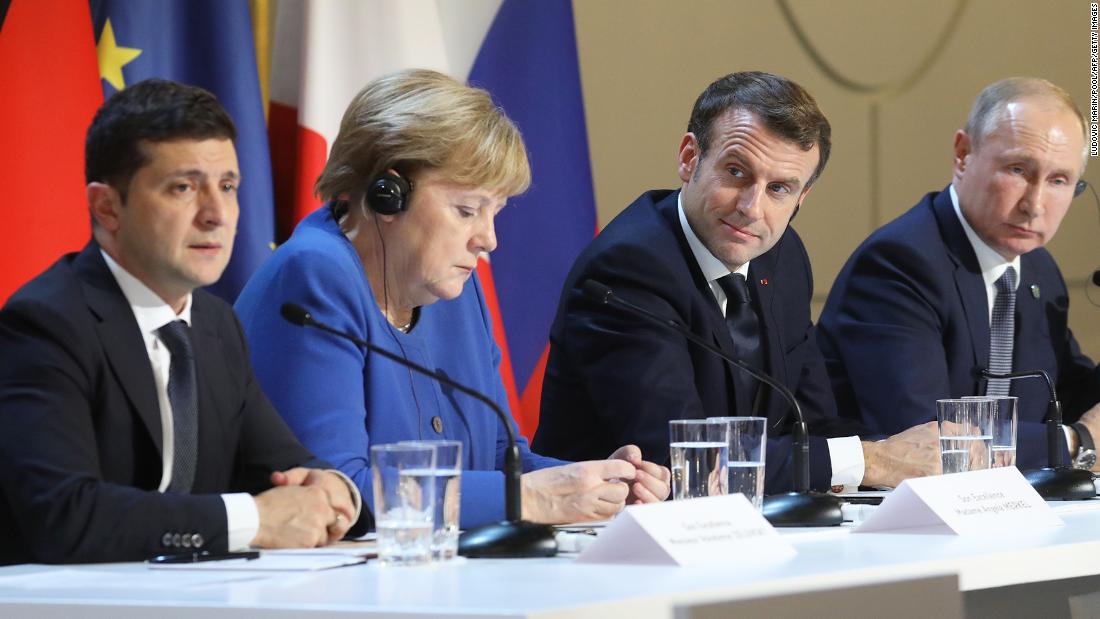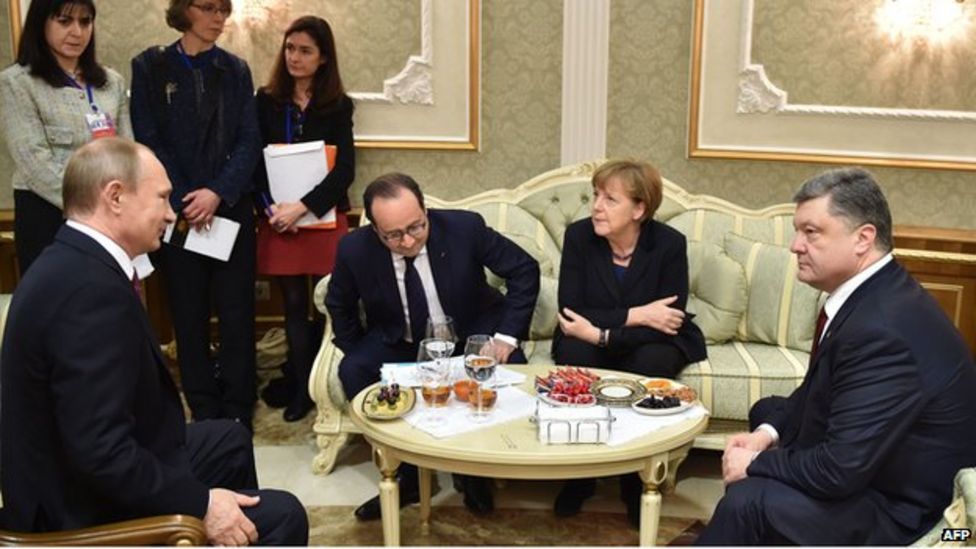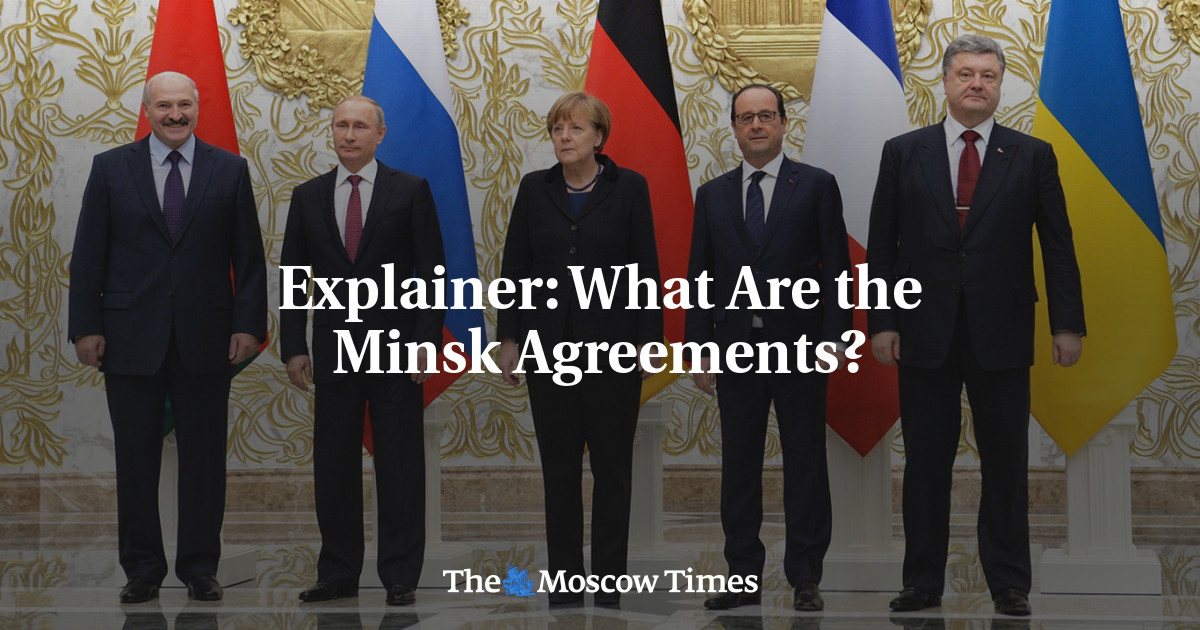
leaders of Ukraine, German, France and Russia
reached a peace agreement to avoid war.
Putin’s Draft Treaty Between
Russia and Ukraine Did Exist
Ted Snider / AntiWar.com
(March 7, 2024) — On June 13, 2022, Russian President Vladimir Putin announced that Russia and Ukraine had “reached an agreement in Istanbul” and that the agreement had been initialed by both sides. On June 17, Putin held up the draft agreement and showed it to a delegation of African leaders.
Representatives from each side of the negotiations have confirmed that a peace was within reach and even that the draft agreement had been arrived at. Russian Foreign Minister Sergey Lavrov backed Putin’s account, saying that “we did hold talks in March and April 2022. We agreed on certain things; everything was already initialed.”
But this is not just a Russian tale. Former Advisor to the Office of the President of Ukraine Oleksiy Arestovych, who was a member of the Ukrainian delegation in Istanbul, says that the negotiations were successful. A second member of Ukraine’s negotiating team, Oleksandr Chalyi, the former Deputy Minister of Foreign Affairs, also reports that they “concluded the so-called Istanbul Communique. And we were very close in the middle of April, in the end of April to finalize our war with some peaceful settlement.”
Intermediaries in the talks from the Turkish foreign minister to the deputy chairman of Turkey’s governing party to then-Israeli Prime Minister Naftali Bennett and former German Chancellor Gerhard Schröder have offered their first-hand testimony in support of the story.
But despite all the overwhelming evidence offered by witnesses, detractors have argued that a peace was nowhere close. Some, employing the long discredited method of knowing Putin’s mind, have argued that if the Russian president really had a draft agreement, then he would have published it.

a session of multilaateral meetings lead to the Minsk Agreement.
But on March 1, The Wall Street Journal revealed that the “draft peace treaty” did exist. The draft that Putin held up for his audience was not a deception. The Wall Street Journal reports that they, “and others familiar with the negotiations,” have “viewed” it. And the draft agreement they viewed bears a very strong resemblance to the one Putin and the delegates to the talks claimed.
The seventeen-page document viewed by the Journal was dated April 15, 2022. That date is consistent with the timing of the Istanbul Communiqué that Putin held up. Oleksandr Chalyi, for example, said they “were very close in the middle of April, in the end of April to finalize our war with some peaceful settlement.”
According to The Wall Street Journal’s reporting, the draft agreement had four key points.
The first was that Ukraine was free to pursue European Union membership. The second was that Ukraine would not be allowed into NATO. The third was that there would be limits placed on Ukraine militarily, and the fourth regarded agreements on culture and territory.
The first point is consistent with Russia’s long stated policy. When asked at the Valdai International Discussion Club meeting of October 5, 2023 whether Moscow’s policy of not objecting to Ukraine joining the European Union had changed, Putin answered, “We have never objected or expressed a negative attitude to Ukraine’s plans to join the European economic community – never.” Consistent with that position, “[t]he draft treaty states that Ukraine [would be] allowed to pursue European Union membership.”
The second point, that Ukraine not be allowed to join NATO, has consistently been reported by all parties to have been the key. The December 17, 2021 proposal on security guarantees that Russia presented to the United States and NATO had as its central premise that NATO not expand into Ukraine. The leader of Ukraine’s negotiating team in Istanbul, Davyd Arakhamiia, says that the “key point” for Russia was that Ukraine “committed that we would not join NATO.” He says that Russia was “prepared to end the war if we agreed to…neutrality.”
Naftali Bennet reports the same. “Tell me you’re not joining NATO,” Bennett says Putin communicated to Zelensky, “I won’t invade.” Schröder says that Ukraine was prepared to give up “NATO membership.”
Perhaps most authoritatively, Ukrainian President Volodymyr Zelensky said on March 27, 2022 that a promise not to join NATO “was the first fundamental point for the Russian Federation,” before adding, “And as far as I remember, they started a war because of this.”
When the draft agreement was first reported by Fiona Hill and Angela Stent in Foreign Affairs, they had already said the outlines of the agreement included that “Ukraine would promise not to seek NATO membership.” The draft agreement displayed by Putin said that Ukraine must return “permanent neutrality” to its constitution.
The third point regarding limits on Ukraine’s military and security guarantees also matches the earlier reports. Schröder says that Ukraine was prepared to give up “NATO membership” in exchange for “compromise” security guarantees. Hill and Stent reported that in exchange for forgoing NATO membership, Ukraine would “instead receive security guarantees from a number of countries.” Zelensky confirms that Ukraine was prepared to agree to exchange a guarantee of “neutrality” for “security guarantees for Ukraine.”
The Wall Street Journal reports that “[t]he treaty was to be guaranteed by foreign powers, which are listed on the document as including the US, UK, China, France and Russia.” This account matches reports by Russian media that the draft Putin revealed listed “Russia, the US, Britain, China, and France… as guarantors.” The Journal goes on to say that “[t]hose countries would be given the responsibility to defend Ukraine’s neutrality if the treaty were violated. But while the treaty held, guarantors would be required to ‘terminate international treaties and agreements incompatible with the permanent neutrality of Ukraine’ including any promises of bilateral military aid.”
The draft peace treaty viewed by the Journal goes on to discuss restrictions and limitations placed on Ukraine militarily. It says that foreign weapons, “including missile weapons of any type,” and “armed forces” from foreign countries would be banned from Ukrainian territory. This too was a key point to the proposal on security guarantees that Putin delivered to the United States and NATO before the war. Not only could Ukraine not be in NATO, NATO could not be in Ukraine: there could be no deployment of weapons or troops in Ukraine. Arestovych also confirms that “we had discussed demilitarization” in the “Istanbul agreement.”
The most striking degree of agreement between the document The Wall Street Journal saw and the document Putin revealed is in the discussion of caps on the Ukrainian Armed Forces. The accounts converge to the number.
The Journal implies that the two sides had agreed to caps on the size of the Ukrainian armed forces but had not yet agreed on what those caps should be. That is consistent with earlier reports by Ukrainian and Russian sources. Oleksiy Arestovych reported that the Istanbul agreement was 90% prepared and that what remained was “the question of the amount of Ukrainian armed forces in peacetime.” He says that “President Zelensky said, ‘I could decide this question indirectly with Mr. Putin.’”
The Journal says that “Moscow wanted Ukraine’s armed forces capped at 85,000 troops,” but that Kiev “wanted 250,000 troops.” Russian media reports of the document held up by Putin provide the exact same numbers: “Moscow proposed to cap the number of military personnel at 85,000 and the number of National Guard members at 15,000. Kiev, meanwhile, proposed that its Armed Forces have up to 250,000 troops.” The draft agreement theJournal saw says that Moscow wanted to allow Ukraine up to 342 tanks, while Kiev wanted 800.
Russian media reports of the document held up by Putin provide the exact same numbers: “Moscow suggested that Ukraine should be allowed to have 342 tanks…Kiev, meanwhile, was in favor of having 800 tanks.” The Journal has new information that Moscow proposed 519 artillery pieces while Ukraine asked for 1,900. Russian media adds that “Moscow suggested… 1,029 armored vehicles, 96 multiple rocket launchers, 50 combat aircraft, and 52 ‘auxiliary’ aircraft,” while Kiev “was in favor of… 2,400 armored vehicles, 600 multiple rocket launchers, 74 combat aircraft, and 86 ‘auxiliary’ aircraft.”
The fourth point, on territory and culture, also reveals intriguing coincidence. Earlier reports, including by Hill and Stent, said “Russia would withdraw to its position on February 23, when it controlled part of the Donbas region and all of Crimea.” There is agreement on Crimea, with The Wall Street Journalreporting that the draft peace agreement it saw says, “The Crimean Peninsula, already occupied by Russia, would remain under Moscow’s influence and not be considered neutral.”
But the Journal version,a first-time revelation, says that “[t]he future of the area of eastern Ukraine covertly invaded and occupied by Russia in 2014, wasn’t included in the draft, leaving it up to Putin and Zelensky to complete in face-to-face talks.” The Journalreporting, therefore, agrees with earlier reporting, with the added surprise that Russia may have been open to withdrawing further east than the February 23 prewar line and returning, not “part of the Donbas,” but all of the Donbas region to Ukraine, perhaps in a return to the Minsk agreement.
The Journal says that the future of the Donbas was left “to Putin and Zelensky to complete in face-to-face talks.” It has been reported previously that after the Istanbul talks, Putin suggested a meeting with Zelensky. And Arestovych says that “The Istanbul agreements were a protocol of intentions and was 90% prepared for directly meeting with Putin. That was to be the next step of negotiations.”

As for the language rights of ethnic Russians in the Donbas after the war, TheJournal reports that “Moscow also pushed for the Russian language to operate on an equal basis with Ukrainian in government and courts,” but identifies that as “a clause Kyiv hadn’t signed off on, according to the draft document.” Arestovych agrees that language rights were discussed, saying “we had discussed… issues concerning the Russian language.” But he more optimistically seems to include those discussions in the “90% prepared” category and not in the category of “what remained.”
Though the intent of The Wall Street Journal report seems to have been to demonstrate how “punishing” Russia’s terms were and to remind the West “of the compromises that Russia might try to force Ukraine to swallow if Western military support dries up,” the significance of the report may lie elsewhere.
This new reporting by the Journal may be significant for three reasons. The first is that it confirms with its alarming consistency earlier reports of how close Russia and Ukraine were to negotiating a peace in the early days of the war.
The second is that it refutes the Western refrain that Putin is not serious about negotiating. His willingness not to stand in the way of Ukraine joining the West and the European Union, his lack of demand for regime change and concession to cap but not entirely demilitarize Ukraine, and the suggestion that the status of all of the Donbas was open to discussion accords more with Oleksandr Chalyi’s testimony that Putin “demonstrated a genuine effort to find a realistic compromise and achieve peace.”
The third, and most important, is that it is a reminder that Ukraine will never again return to terms as favorable as the ones they had tentatively agreed to in the first days of the war before the West put an end to the negotiations. It is a reminder that, as the war goes agonizingly on, the situation is only getting worse for Ukraine on the battlefield and that it is finally time to walk off into the negotiating room.
Each day delayed now means more deaths on the battlefield and worse terms in the negotiating room. It is time for the West to stop providing support for the battlefield and start pushing for a return to the negotiating room.
Ted Snider is a regular columnist on U.S. foreign policy and history at Antiwar.comand The Libertarian Institute. He is also a frequent contributor to Responsible Statecraft and The American Conservative as well as other outlets. To support his work or for media or virtual presentation requests, contact him at tedsnider@bell.net.
Posted in accordance with Title 17, Section 107, US Code, for noncommercial, educational purposes.